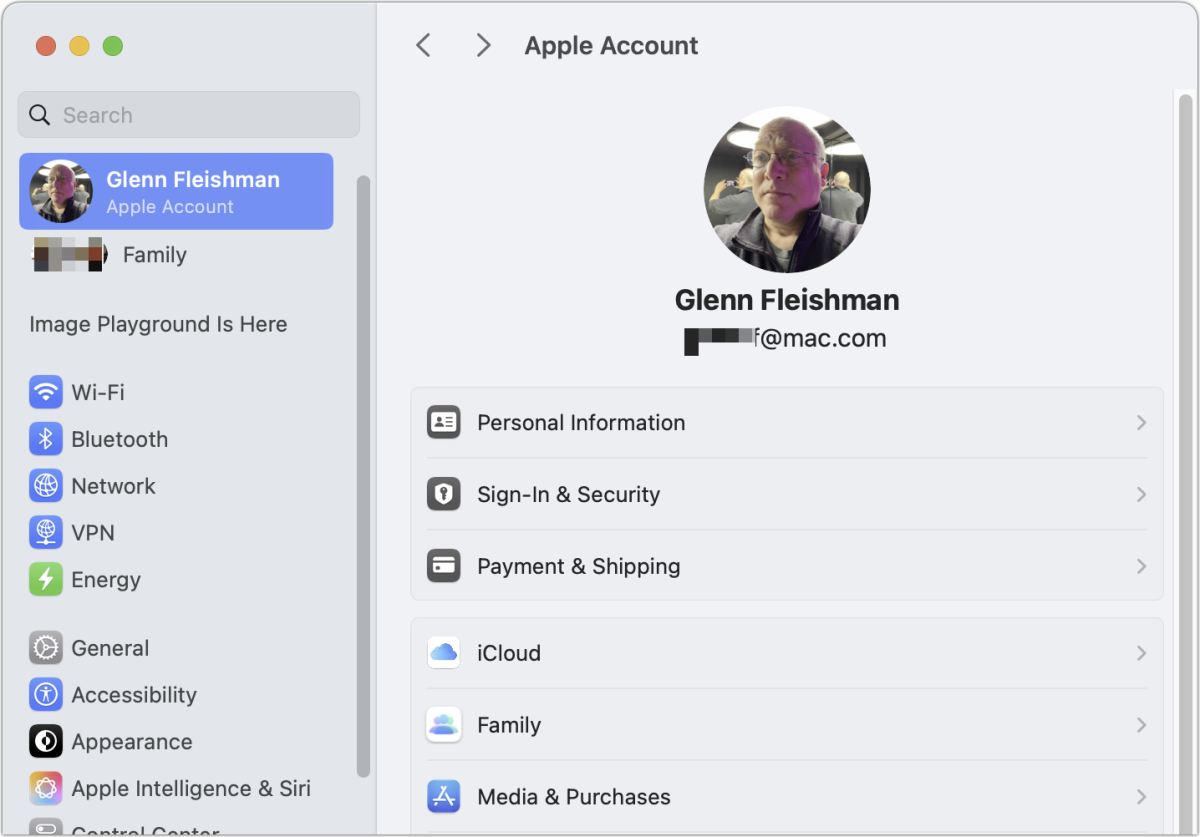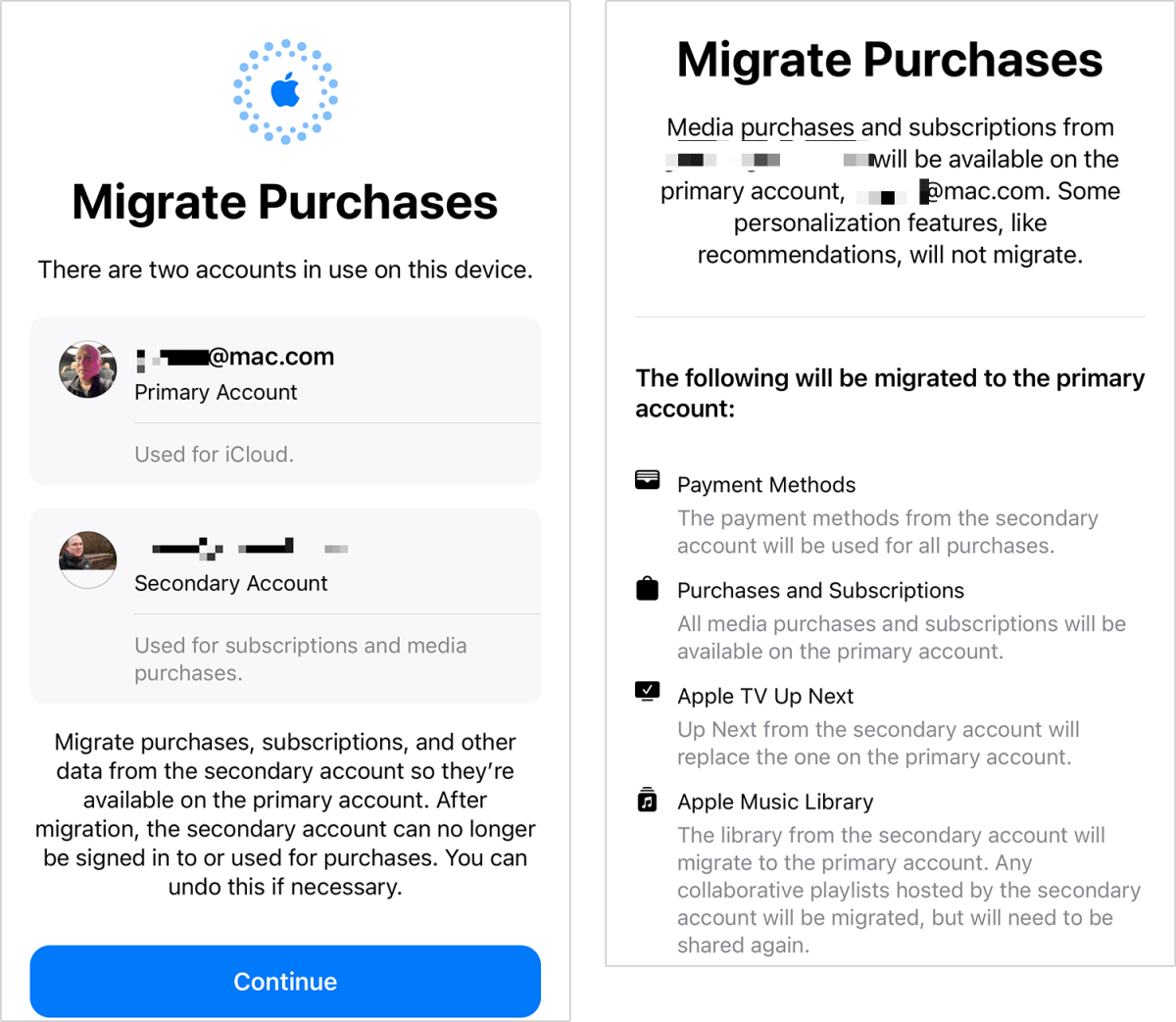One of the most common questions asked of Mac 911 is, “How do I merge or transfer purchases from one Apple ID/Account to another?” The answer for over 20 years has been the same: You can’t. Until now.
Way back in the mists of time–the year 2000–Apple created iTools, its first cloud-hosted service, about six years before “cloud computing” even existed as a term. As part of iTools, you registered an account name paired with an @mac.com address. iTools later morphed into .Mac (2002) and MobileMe (2008, @me.com) before settling into iCloud (2011, @icloud.com).
The iTunes Music Store first appeared in 2003. It also required you to set up an account, one that was separate from your iTools/.Mac account. Thus began the great sundering for old-school users. We had iCloud on one Apple Account and purchases on another. (Apple changed the Apple ID name to Apple Account in September 2024, so I’ll use that to avoid confusion.)
It wasn’t until a few years later that a new user could register a single Apple Account that handled everything: email, cloud-stored data for synchronization, access to Apple website’s services, and purchases. Apple didn’t provide a way for people with an iTools/.Mac/MobileMe account and an iTunes Music Store account to merge them, even when both became effectively an “Apple Account.”
Then, with no fanfare, Apple posted a set of support notes on Feb. 11, 2025, that explained how to use a new migration feature that allows you to transfer all purchases from one Apple Account to another. The process is straightforward, and Apple even offers an option to back out of the migration, or “un-migrate” your files.
You can find the support notes at:
The way Apple presents the information can be overwhelming. I’ve simplified and reorganized into a more understandable set of preparations and processes for you. Here’s what you need to know.
What Apple migrates
Apple defines the two accounts you’re migrating purchases to and from as the primary Apple Account, which has iCloud information associated, is the main account you use on your devices, and will receive the purchases; and the secondary, which has purchases and limited other information which is migrated to the primary account. I’ll use those terms extensively below.
Your primary account will appear at Settings/System Settings > your name at the top of the screen below your name. Your secondary, purchases account appears in the same location when you tap or click Media & Purchases.

Migration moves all your purchases of apps, books, movies, music, and TV shows from the secondary to primary account. It also moves five other sets of information, each with its own peculiarities:
- Payment methods: All payment methods associated with the secondary account move to and replace payment methods stored for the primary account.
- Subscriptions: The secondary account’s subscriptions merge with the subscriptions on your primary account.
- Music library: If the secondary account has a music library, migration replaces all music-related items on the primary account with the secondary’s: the music library data, personalization profile, social profile, and Apple Music Replay. If there’s no secondary library, the primary account’s music data is untouched.
- Podcasts: The same is true for podcasts: secondary data replaces primary unless there’s no podcast information in the secondary account.
- Up Next queue in TV app: If you use the Up Next queue in the TV app, the secondary account’s list replaces the primary account’s.
Migration leaves behind:
- iCloud data: I recommend exporting iCloud data before migration for easier access. This column should help.
- Reviews: Any reviews you created with the secondary account can no longer be edited.
- Personalized recommendations: Your personalized recommendations in the App Store, Books, Podcasts, and TV apps are abandoned.
If you’re part of any beta test programs that rely on Apple’s TestFlight app, the migration process is currently broken for that as of mid-February 2025. You cannot use your primary or secondary account’s email address to log in. Contact the developer for information about obtaining an interim URL that you can use in lieu of a login.
After you migrate purchases, the account you migrated from can no longer be used as an iCloud or purchases account on an iPhone, iPad, Mac, or Apple TV. However, it’s still reachable via iCloud.com.
Get ready to migrate
Migration comes with a large number of requirements you have to meet before you can begin.
Account information: Both accounts have to be active and unlocked and both must have two-factor authentication enabled. If you deleted or disabled a purchases account in the past, it’s not eligible. Neither account can previously have been part of a migration: it’s a one-time operation in one direction for the future lifetime of the account (as of now). You can’t, for instance, roll two purchases-only accounts into one iCloud account. (The exception is that you can undo the migration, which resets that status; see later in the article.)
Location: Both accounts must be set to the same country and region for purchases. Apple currently excludes the European Union, India, and the United Kingdom from migrations.
Family Sharing: If you’re part of a Family Sharing group, the secondary account must be in the same group as the primary or in no group at all. A child account created through a Family Sharing group that is still in “child” status can’t be used for either side of a migration; as one consequence, you’re prevented from migrating a child’s purchases into your own account. The secondary account must have Purchase Sharing disabled if it’s in a Family Sharing group.
Purchases: Even though the primary account should be the one you use for iCloud, it must have at least one purchase or free download associated. If you’ve never used the primary account this way, you need to buy or download something free using that account before starting.
The secondary account’s payment method must be available for active use, so check that you have an up-to-date card associated.
The secondary account can’t be migrated from until 15 days following its last purchase. Further, all pre-orders and rentals must be fulfilled. For rentals, you can just start watching to run down that clock. You can cancel pre-orders; see this support note.
Miscellaneous: Two miscellaneous requirements might trip you up. It’s possible to have an Apple One account and designate its storage for a third Apple Account, neither primary nor secondary. If that’s the case, you can’t migrate the secondary account. You will need to unwind that association before starting. And if your Apple Account has access to “special” apps or content, such as that via Apple’s Volume Purchase Program (VPP) for schools and companies, it can’t be used either as a primary or secondary account.
Start the migration
Start the process on an iPhone or iPad that has the primary account logged in as the iCloud/main account:
- Go to Settings > your name > Media & Purchases.
- Tap View Account.
- Authenticate with Touch ID, Face ID, or a password if required.
- Tap Migrate Purchases.
- Enter passwords and other authentication for the primary or secondary accounts as prompted.
- The first Migrate Purchases screen identifies which account is being treated as primary and which as secondary and provides additional information. Tap Continue to proceed.
- A second Migrate Purchases screen appears with an extensive description of what data will migrate, how it will replace primary data or be merged with it, and what categories of purchase-related information will be left behind and unusable. Tap Continue to move forward.
- A final screen labeled Finish Migration makes one final set of declarations, including that you can’t sign into the secondary account in the future, though it means just from an Apple device as an iCloud or purchases account. Tap Migrate.
- Purchases Have Been Migrated will appear and both Apple Accounts will receive confirmation via their respective emails.
- On each of your devices, sign out of the secondary account under Media & Purchases and sign into the primary account.

IDG
You may experience errors in this process if you haven’t met some of the requirements documented earlier. Apple should provide details on what remains to be done in order to migrate successfully.
Reverse migration
If you experience problems or decide the merged Apple Account doesn’t meet your needs for some reason, you can reverse the process. Reversing migration rolls back time in some ways and not in others:
- Payment methods: All payment methods are removed from both accounts. You have to add them back.
- Purchases after the migration: All purchases made after the migration remain with the primary account. All purchases on the secondary account prior to the migration move back.
- Subscription cancellation: Except for iCloud+, all other subscriptions are canceled and have their expiration date set to their next renewal. However, you can resubscribe on either account.
- Music and podcast migration: Music-related data that was migrated from the secondary account, like a music library or social profile, will migrate back; the same is true for podcasts. If the secondary account had no music-related or podcast data besides purchases, that stuff remains on the primary account.
- Up Next queue reverts: The Apple TV app’s Up Next queue reverts to where it was for each of the primary account and secondary account before the migration.
To undo the migration, follow this process:
- Go to Settings > your name > Media & Purchases.
- Tap View Account.
- Authenticate with Touch ID, Face ID, or a password if required.
- Find the section labeled Secondary Account and tap Undo Migration.
- Follow the explanatory steps about what reversing the migration entails and tap the necessary button at each step to continue.
- Undo Migration Complete appears and both Apple Accounts will receive a confirmation via their email addresses.
- On all your devices, sign out of the primary account in Media & Purchases and sign back into the secondary account.
Ask Mac 911
We’ve compiled a list of the questions we get asked most frequently, along with answers and links to columns: read our super FAQ to see if your question is covered. If not, we’re always looking for new problems to solve! Email yours to mac911@macworld.com, including screen captures as appropriate and whether you want your full name used. Not every question will be answered; we don’t reply to emails, and we cannot provide direct troubleshooting advice.



